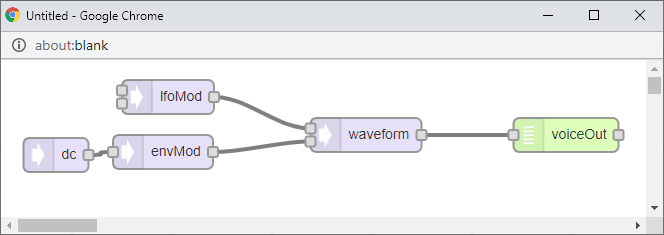I am trying to create a reusable class synth that would build the connection between my different audio objects. But when I try to instance the AudioConnection within this class it doesn't work :-/ (seem I reached my knowledge in C++  )
)
I actually beleive that I could even create a new audio object like describe here https://www.pjrc.com/teensy/td_libs_AudioNewObjects.html but I have even less an idea about how to do this in order to connect all those sub audio object.
I am a bit lost and I would love to get some help to find my way.
Code:
AudioOutputMQS audioOut;
Synth synth{&audioOut};
class Synth {
protected:
public:
AudioConnection patchCord01;
AudioConnection patchCord02;
AudioConnection patchCord03;
AudioConnection patchCord05;
AudioConnection patchCord06;
AudioSynthWaveformDc dc;
AudioEffectEnvelope envMod;
AudioSynthWaveformModulated lfoMod;
AudioSynthWaveformModulated waveform;
AudioEffectEnvelope env;
byte currentWaveform = 0;
float attackMs = 0;
float decayMs = 50;
float sustainLevel = 0;
float releaseMs = 0;
float frequency = 440;
float amplitude = 1.0;
Synth(AudioStream* audioDest)
: patchCord01(lfoMod, waveform),
patchCord02(dc, envMod),
patchCord03(envMod, 0, waveform, 1),
patchCord05(waveform, env),
patchCord06(env, *audioDest) {
waveform.frequency(frequency);
waveform.amplitude(amplitude);
waveform.arbitraryWaveform(arbitraryWaveform, 172.0);
waveform.begin(WAVEFORM_SINE);
lfoMod.frequency(1.0);
// lfoMod.amplitude(0.5);
lfoMod.amplitude(0.0);
lfoMod.begin(WAVEFORM_SINE);
env.attack(attackMs);
env.decay(decayMs);
env.sustain(sustainLevel);
env.release(releaseMs);
env.hold(0);
env.delay(0);
dc.amplitude(0.5);
envMod.delay(0);
envMod.attack(200);
envMod.hold(200);
envMod.decay(200);
envMod.sustain(0.4);
envMod.release(1500);
}
void noteOn() {
envMod.noteOn();
lfoMod.phaseModulation(0);
env.noteOn();
}
void noteOff() {
env.noteOff();
envMod.noteOff();
}
// and some more function to control everything...
};
// Uncommenting the following code would make the whole thing working
// But i want the connection happening within the synth class
//AudioConnection patchCord01(synth.lfoMod, synth.waveform);
//AudioConnection patchCord02(synth.dc, synth.envMod);
//AudioConnection patchCord03(synth.envMod, 0, synth.waveform, 1);
//AudioConnection patchCord05(synth.waveform, synth.env);
//AudioConnection patchCord06(synth.env, audioOut);I actually beleive that I could even create a new audio object like describe here https://www.pjrc.com/teensy/td_libs_AudioNewObjects.html but I have even less an idea about how to do this in order to connect all those sub audio object.
I am a bit lost and I would love to get some help to find my way.



